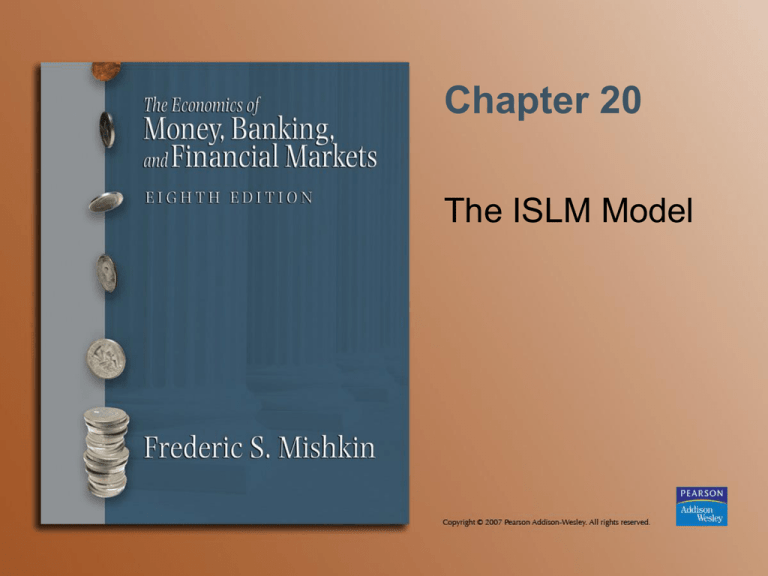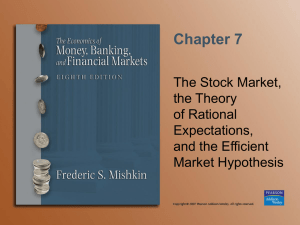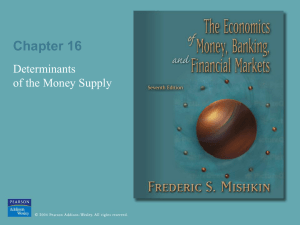
Chapter 20
The ISLM Model
Determination of Aggregate Output
T he total quantity dem and ed o f an econo m y's
output is the sum o f four types of sp ending
Y
ad
C I G NX
E quilibrium occurs in th e eco nom y
w hen the total quantity o f outp ut su pplied
equals the total quantity of outpu t dem anded
Y Y
ad
A nalysis assum es the p rice lev el is fix ed
Copyright © 2007 Pearson Addison-Wesley. All rights reserved.
20-2
Consumption Expenditure and the
Consumption Function
Incom e is the m ost im portant factor determ ining consum ption spending
D isposable incom e (Y D ) is total incom e less taxes (Y - T)
T he m arginal propensity to consum e (m pc ) is the slope of
the consum ption function ( C / Y D ), the change in consum er
expenditure that results from an ad ditional dollar of disposable incom e
a is autom onous consum er expenditure, the am ou nt of consum er
expenditure that is independent of disposable incom e (how m uch
w ill be spent w hen disposable incom e is 0)
C a m pc(Y D )
Copyright © 2007 Pearson Addison-Wesley. All rights reserved.
20-3
Copyright © 2007 Pearson Addison-Wesley. All rights reserved.
20-4
Copyright © 2007 Pearson Addison-Wesley. All rights reserved.
20-5
Investment Spending
• Fixed investment—always planned
• Inventory investment—can be unplanned
• Planned investment spending
Interest rates
Expectations
Copyright © 2007 Pearson Addison-Wesley. All rights reserved.
20-6
Copyright © 2007 Pearson Addison-Wesley. All rights reserved.
20-7
Expenditure Multiplier
A change in planned investm ent spending leads to an even larger
change in aggregate output
A n increase in planned investm ent spending leads to an
additional increase in consum er expenditure w hich raises aggregate
dem and and output further
Y (
1
1 m pc
Y / I (
Copyright © 2007 Pearson Addison-Wesley. All rights reserved.
) I
1
1 m pc
)
20-8
Copyright © 2007 Pearson Addison-Wesley. All rights reserved.
20-9
Copyright © 2007 Pearson Addison-Wesley. All rights reserved.
20-10
Changes in Autonomous Spending
A n y ch an g e in auton o m o u s sp en d in g w ill lead to a m u ltiplied
ch ang e in agg regate outp ut
Y ( a I )(
1
1 mpc
)
T he sh ift in th e ag gregate d em and fun ctio n can co m e from a
ch an g e in p lan n ed in vestm ent, a ch an ge in au to no m ous
co nsu m er spen ding , or b oth
C han ges in au to no m ous spen din g are do m in ated by
anim al spirits
Copyright © 2007 Pearson Addison-Wesley. All rights reserved.
20-11
Government’s Role
G o v ern m en t sp en d ing an d tax es
can b e u sed to ch an g e th e p o sitio n o f th e
ag g reg ate d em an d fu n ctio n
G o v ern m en t sp en d in g ad d s d irectly
to ag g reg ate d em an d
T ax es d o n o t affect ag g reg ate d em an d d irectly
C a [ m p c (Y T )] a ( m p c Y ) ( m p c T )
If tax es ch an g e, co n su m er ex p en d itu re ch ang es
in th e o p p o site d irectio n
C -m pc T
Copyright © 2007 Pearson Addison-Wesley. All rights reserved.
20-12
Copyright © 2007 Pearson Addison-Wesley. All rights reserved.
20-13
Role of International Trade
A change in net exports (exports - im ports) is positively
related to changes in aggregate output
Y NX (
Copyright © 2007 Pearson Addison-Wesley. All rights reserved.
1
1 m pc
)
20-14
Copyright © 2007 Pearson Addison-Wesley. All rights reserved.
20-15
Copyright © 2007 Pearson Addison-Wesley. All rights reserved.
20-16
The ISLM Model
• Includes money and interest rates in the
Keynesian framework
• Examines an equilibrium where aggregate output
equals aggregate demand
• Assumes fixed price level where nominal and real
quantities are the same
• IS curve is the relationship between equilibrium
aggregate output and the interest rate
• LM curve is the combinations of interest rates and
aggregate output for which MD = MS
Copyright © 2007 Pearson Addison-Wesley. All rights reserved.
20-17
Equilibrium in the Goods Market:
The IS Curve
• Interest rates and planned investment spending
Negative relationship
• Interest rates and net exports
Negative relationship
• The points at which the total quantity of goods
produced equals the total quantity of goods demanded
• Output tends to move toward points on the curve that
satisfies the goods market equilibrium
Copyright © 2007 Pearson Addison-Wesley. All rights reserved.
20-18
Copyright © 2007 Pearson Addison-Wesley. All rights reserved.
20-19
Copyright © 2007 Pearson Addison-Wesley. All rights reserved.
20-20
Copyright © 2007 Pearson Addison-Wesley. All rights reserved.
20-21
Equilibrium in the Market for Money:
The LM Curve
• Demand for money called liquidity
preference
• Md/P depends on income (Y) and
interest rates (i)
• Positively related to income
Raises the level of transactions
Increases wealth
• Negatively related to interest rates
Copyright © 2007 Pearson Addison-Wesley. All rights reserved.
20-22
Equilibrium in the Market for Money:
The LM Curve (cont’d)
• Connects points that satisfy the
equilibrium condition that MD = MS
• For each level of aggregate output, the
LM curve tells us what the interest rate
must be for equilibrium to occur
• The economy tends to move toward
points on the LM curve
Copyright © 2007 Pearson Addison-Wesley. All rights reserved.
20-23
Copyright © 2007 Pearson Addison-Wesley. All rights reserved.
20-24
Copyright © 2007 Pearson Addison-Wesley. All rights reserved.
20-25






